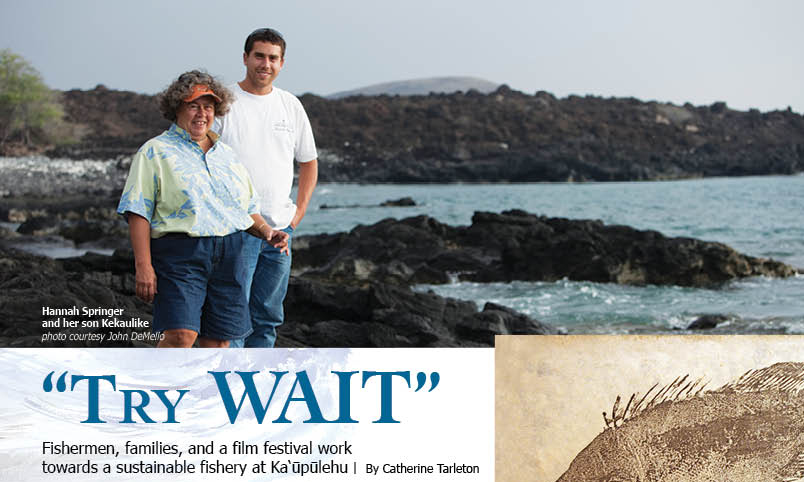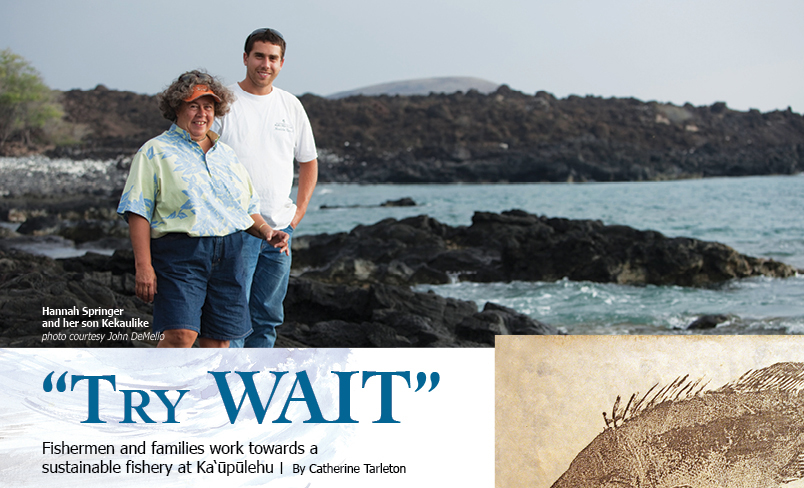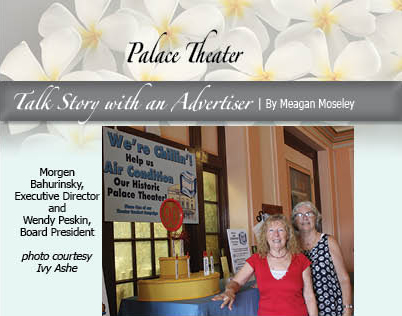
“Try Wait”: Fishermen and Families Work Towards a Sustainable Fishery at Ka‘ūpūlehu

By Catherine Tarleton
Around the world’s oceans, fish and seafood populations are shrinking at an alarming rate due to overfishing and other factors. In Hawai‘i, specifically on the West Coast of Hawai‘i Island, anecdotal and scientific data point to steep declines in many species of fish and marine life, including shellfish, corals, seaweeds, and other ocean plants.
According to the World Wildlife Federation, two-thirds of the world’s fish stocks are either fished at their limit or over-fished. Additionally, the United Nations Food and Agriculture Organization estimates that 70 percent of the total fish population is fully used, over-used or in crisis.
In the coastal Ka‘ūpūlehu area of North Kona, fish abundance declined 41% between 1992 and 1998, and fish diversity decreased 41%. In addition, coral cover decreased from 40.71% in 2003 to 27.05% in 2011, according to University of Hawai‘i studies.
Palau inspires
Palau, an independent nation of 250 islands in the West Pacific, uses a traditional sustainability model called “bol,” similar to the Hawaiian “kapu” system. This allows for restrictions on fishing during certain times of the year in order for a population to replenish itself.
Under the guidance of Noah Idechong, former Speaker of the House of Palau’s National Congress and co-founder/director of the Palau Conservation Society, Palau has worked with local fishing communities to reinstate the bol fishing restrictions, thus melding modern marine conservation science with traditional knowledge. As a result, Palau’s economy benefitted from an upturn in tourism, specifically as a diving destination. And, with some 700 species of coral and 1,400 species of fish, Palau is ranked #1 on the list of the “Seven Underwater Wonders of the World.”
Here on Hawai’i Island, the Ka‘ūpūlehu Marine Life Advisory Committee (KMLAC) is working on a plan similar to the Paualan model, called “Try Wait.”
“Try Wait”
“It’s a very simple concept—by not taking the big fish out of the ocean, the population can recover,” says Chad, an Alabama native who came to UH-Hilo in 2000 to study the coral reefs. In 2009, Chad began working with the Nature Conservancy at Ka‘ūpūlehu—at the invitation of the KMLAC.
A volunteer collaboration of scientists, lineal families, and other stakeholders, KMLAC was established in 1997 as a result of an intervention on an Army Corps of Engineers permit application to dredge near-shore waters at Ka‘ūpūlehu. It included representatives of the parties to the case: Kona Hawaiian Civic Club, Office of Hawaiian Affairs, Kamehameha Schools (landowners), and Hualālai Development (lessee/applicant). Kama‘āina (child of the land) members sit with the KMLAC as “Nā Kupuna.”
KMLAC has since broadened participation to include natural resource managers, educators, scientists, and state agency officials, including Division of Conservation and Resources (DOCARE).
Chad also serves on the West Hawai‘i Fisheries Council (WHFC), an advisory group that formulates and recommends management actions to the State Department of Land and Natural Resources. His work takes him up and down the coast, gathering data, working with local communities and learning more about the history of the area and its evolution.
“In 1973, the Queen Ka‘ahumanu Highway was built and resources declined. In the 1990s, the Hualālai resort was built and resources declined,” says Chad. “With more people having ocean access, there are a lot fewer fish. The impact from that access has been demonstrated very clearly.”
This impact has resulted in the “Try Wait” program. Through the efforts of many, over years of work, a specific concept has emerged as a goal of the program, and as a pointer towards solutions. “Try Wait,” adapts the ancient kapu system and urges the public to refrain from fishing in the area for 10 years, thus allowing a natural process of re-population.
Chad says Ka‘ūpūlehu-Kūki‘o is the only area in the state that has identified such an approach. “The members of the community are the ones living with this system and the ones suggesting change.”
“We are working there to understand the health of the fish and coral community as well as the tidal community,” says Chad, who works closely with families who have ancestral connections to the area. “The real story is the families’ perspective. Our baseline for health comes from a many-hundreds-of-years-old fishery.”
One of those families includes kama‘āina Hannah Kihalani Springer, a member of KMLAC as well as a founding member of WHFC.
Kama‘āina perspective
“It is our story, and in this century, in this season, it comes to include a host of others,” says Hannah.
“Our family has been here since before the rise of Kamehameha, my father’s people at Ka‘ūpūlehu and my mother’s at Kūki‘o. My maternal great-great-grandfather founded Hu‘ehu‘e Ranch which included the family land of Kūki‘o and we at one time held the Kamehameha Schools lease on Ka‘ūpūlehu.”
Hannah’s health and well-being have been shaped by her lifelong relationship with these lands and near by Manini‘ōwali, where she recalls body surfing, even before Queen Ka‘ahumanu Highway was built. In those days, boat travel was best; otherwise they would go by Jeep to Kuili and walk the rest of the way in to Manini‘ōwali and Kūki‘o.
“In 1975, Queen Ka‘ahumanu Highway opened, and we saw the unintended consequences of that mighty public work,” says Hannah. “When development came to Kūki‘o in the 1990s, we were skeptical and accepting.”
“Resorts have bloomed down there—and we are engaged through professional consultation, regular employment and volunteerism,” she says, referring to her and others’ work to preserve the unique character of the region as well as the environment and the creatures who live there. “So many people decry the resorts and developments, but without them, the County would not have enacted the public access that they use to reach these areas.”
Today, the West Hawai‘i Regional Fishery Management Area extends along 116 miles of coastline from ‘Upolu (Hawi) to Ka Lae (South Point). There is an Aquarium Fish Replenishment Area in Ka‘ūpūlehu-Kūki‘o, a precedent-setting national permit declaring the need for the protection of kūpe‘e, limu, and other species based on their cultural, not environmental, value.
“Try Wait”—is kama‘āina and people in Hawai‘i, with or without the koko Hawai‘i (Hawaiian blood), practicing the tradition of refraining from harvest,” says Hannah, “And that is as important a responsibility as the right to harvest… Article 12, section 7 of the Hawai‘i State Constitution protects rights of practitioners. We are suggesting that the practice of refraining from harvest deserves protection too.”
‘Aloha kekahi i kekahi’
Hannah expresses gratitude for citizens who take the time to sit on boards and attend public meetings, to work with existing systems toward solutions, and to guide behaviors toward long-term goals. The approach is not without obstacles, however, and the process can be arduous, often adversarial in nature.
“Foremost, families did not break ‘aloha kekahi i kekahi’ (aloha from one to another),” says Hannah. “We never adopted the role of adversaries. We used the full depth and breadth of our skill sets, and that allowed for incisive exchanges, not emotionally harmful, exchanges that were intellectually engaging.”
“The ‘āina shapes our world view—our humor—our approaches to problems,” says Hannah. “That’s our behavior pattern. We are engaged and influential in our homeland, acting on behalf of this land and its seas that we love so much. Kama‘āina are children of the land; and in the same way that families shape their members, we are shaped by the ‘āina that we describe ourselves as kama of.”
“Our children—in them and in their children are all kinds of hopes and promises,” says Hannah. “There will be continuation of relationship with the land.”
Not the end of the line, yet
Award-winning filmmaker Rupert Murray, in The End of the Line, traveled the world’s oceans to document horrific losses of fish from humankind’s predation. From the Chesapeake Bay to Newfoundland, Scotland, Gibraltar, Senegal, and Japan, fishing industries have dwindled, nets are empty and demand soars. Yet he does not see the situation as hopeless, as quoted in his Director’s Statement.
“It only seems overwhelming if you concentrate on the negative side of the issue. If you look at how simple and universally agreed the solutions are, that the fishing industry is a relatively small industry to regulate properly, that a global network of marine reserves would cost the same as the amount we spend on ice cream, then I believe you can remain hopeful and positive. Healthy oceans are win, win, win, for fishing and coastal communities, for the health of our planet, for our diet, for our future. I want people to take away the fact that the oceans salvation is in our grasp. Firstly I want people to question their eating habits, and question the people who supply them with fish and try to buy only sustainably caught fish. Secondly we want to have an influence on political decisions so people should spread the word about the film and join our campaign.”
What can we do?
-
- “Try Wait”. If you are a fisherman, refrain from harvesting in protected areas.
- Take only the resources (fish, seafood, seaweed) you need for your family.
- When swimming and snorkeling, be mindful where you put your feet. Never step or stand on the coral reef.
- Use ocean-friendly sunscreens, those that don’t put chemicals into the ocean.
- Report noteworthy changes or conditions to the Eyes of the Reef (eorhawaii.org) or other monitoring network.
- Participate in the democratic system. Attend public hearings. Keep informed. Make your vote count.
- Volunteer for tracking and monitoring networks, sit on councils and committees relevant to you, your family, your neighborhood.
- Know where your fish comes from and how it has been caught. Ask questions at sushi restaurants.
- Try tasting different kinds of smaller fish instead of tuna, marlin, or swordfish.
- Make mindful choices in local business—about purchasing, contracting, and operations.
- Learn more about the oceans and marine life through public events.
- Attend the Waimea Ocean Film Festival being held January 1–8, 2016.
- If you have 200 people fishing righteously, it’s still 200 times the effect of one person. ❖
Resources
The Nature Conservancy Hawai‘i
Ka‘ūpūlehu Marine Life Advisory Committee.
The End of the Line.
Department of Aquatic Resources identifies 10 regulated fishing areas on Hawai‘i Island:
• Hilo Harbor, Wailoa River, and Wailuku River
• Waiākea Public Fishing Area
• West Hawai‘i Regional Fishery Management Area
• Kailua Bay
• Kawaihae Harbor
• Keauhou Bay
• Kīholo Bay
• Kona Coast
• Puakō Bay and Puakō Reef
• South Kona (Miloli‘i)
DLNR Fishing Regulations
Contact the writer


